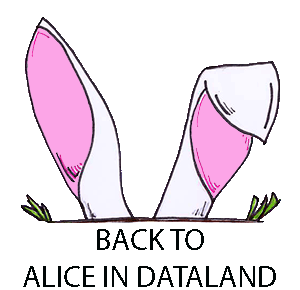
When we last saw Alice, she was fleeing from an oversized puppy in a greenscreened garden: a "photographic space" within Wonderland, where Alice confronted the "defamiliarization of perception" that Franz Meier describes as crucial in a land where identity is threatened by time. We now enter a medium in which time is dictated by the space between panels, the comic—although as we were already in the image-text space, this terrain can feel familiar: Joseph Witek notes that we know a comic by the fact that it is "read as a comic" (149). (We see Alice drawn, looking over her shoulder at her photographic predecessor, both mid-run.) As Alice leaves behind her photographic dreamworld, "The images move from one Alice to the next... suggesting that the 'true' Alice is only to be found somewhere between them" (Monteiro 105).
(We see Alice running through a field of mushrooms). This description of Alice's relationship with the space between images translates across media and recalls the work of comics scholar Scott McCloud, who spoke of the reader's agency in closing such gaps: closure, the "phenomenon of observing the parts but perceiving the whole" (64).
As we follow Alice into the land of comics, we are likewise only seeing part of the picture. Alice already inhabited the space between images and text. Tenniel was a comics illustrator before he shaped Wonderland. And as Alice encounters the caterpillar, with his unanswerable query "Who are you?", she has moved from mediums with an image-text relationship parallel to comics to a full-blown world of sequential art, from Disney Comic Books (starting in 1951) to Bryan Talbot's Alice in Sunderland (2007).
Caterpillar: "Who are you?"
Alice: "I hardly know sir, just at present—at least, I know who I was when I got up this morning, but I think I must have been changed several times since then."
Alice finds no further stability of identity in comics, as she moves from the slapstick Disney adaptations to the surreal Sunderland. The caterpillar enforces Wonderland's rules, and in doing so reminds Alice that she is the one out of order here—not Wonderland: "What do you mean by that? Explain yourself!"
We see Alice reading her own adaptations and reflection: "Curiouser and curiouser! These Alices aren't me—I'm not old, and my Mad Hattr has never fought a man-bat-creature. And wherever this Sunderland place is, I'm quite sure I've never been there." She speaks: "I can't explain myself, I'm afraid, sir, because I'm not myself. When you have to turn into a butterfly, I should think you'll find it a little queer, won't you?"
Caterpillar: Not a bit.
Alice: But these books—being so many different media in a day is confusing. Fitting in a panel is so limiting.
Caterpillar: What's wrong with fitting in a panel?
Alice: Nothing!
Caterpillar: Are you content now?
Alice: I might be content—or am I the medium? The message? The massage? I've quite lost myself.
Caterpillar: You were all wrong from beginning to end.
(We see Alice sitting on the Caterpillar's mushroom after he has departed.) Perhaps Alice's confusion stems from being other than text. As Alexander Galloway defines an interface: "The interface asks a question and, in doing so, suggests an answer" (30). An interface is not a "thing," Galloway goes on to explain, but an "effect" (36).
If we agree with George Bluestone, this is no longer Alice: "Because language has laws of its own, and literary characters are inseperable from the language which forms them, the externalization of such characters often seems disatisfying" (23). Can we tear the medium from the message? Is Alice more than content? (We see Alice reaching out of her panel to eat a mushroom.)
But if we think of Alice as other than literary, we can consider Alice as an interface by Galloway's definition—"an 'agitation' or generative friction between different formats" (31). Such friction is disruptive to a medium just as Carroll's work "plays on the formal and cognitive properties of language to disrupt linguistic laws," a trend of rule-breaking that Kamilla Elliott describes as characteristic of any great film adaptation of Alice in Wonderland (198). Brian McHale sums up this need in examining recent adaptations: "postmodern Alice is postmodernism in a nutshell."
(We see the pigeon, and Alice's next growing far away from her body below.)
Pigeon: Serpent!
Alice: I'm not a serpent, I'm... I'm a little girl.
Pigeon: A likely story indeed! I've seen a good many little girls in my time, but never one with such a neck as that. Next you'll be telling me you've never tasted an egg.
Alice: I have tasted eggs, certainly—but little girls eat eggs quite as much as serpents, you know.
Pigeon: If they do, why, then they're a kind of serpent, that's all I can say. You're looking for eggs, I know that well enough, and what does it matter to me whether you're a little girl or a serpent?
Alice's encounter with the pigeon raises more questions of her identity, as Alexander Galloway raises another question: "What would it mean to say that 'interface' and 'media' are two names for the same thing?" (31). Is Alice content? Medium? Message? Or an interface for disrupting them all?
Or a lens for disrupting them all?